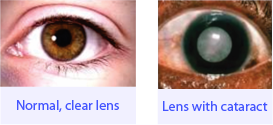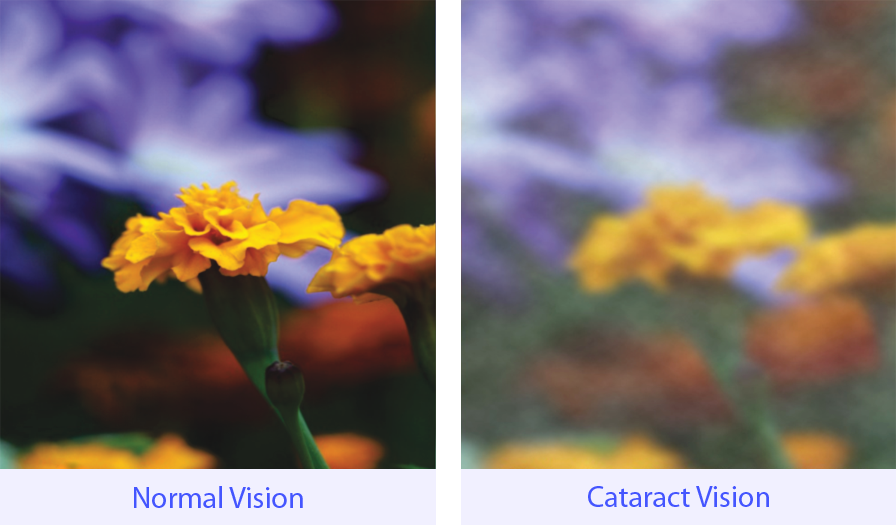A cataract is an opacity (or cloudiness) in the lens of the eye. This restricts light passing through the eye and reaching the retina. When this occurs, vision is affected.

Common symptoms of cataracts are:
The most common cause of cataracts is aging.
Others include:

Modern cataract or lens replacement surgery is one of most successful surgeries known. It is effective in restoring vision to most patients. The surgeon makes a tiny incision on the side of the cornea, removes the eye’s clouded natural lens after dissolving it (using a procedure known as Phacoemulsification) and then replaces it with an artificial ‘Intraocular Lens’ (IOL). Because the incision is very small, stitches are not required and the eye heals quickly, allowing the patient to return to routine lifestyle within a week. Modern cataract surgery is a safe outpatient procedure that barely takes about 10 minutes. Newer advancements such as whitestar phaco (cold phaco) and microincisional phaco emulsification (MICS) have increased its safety even further.
An Intraocular Lens (IOL) is the replacement lens that is surgically implanted in the eye to replace the existing natural clouded lens during cataract surgery.
The design of IOL decides your need for spectacles after the surgery. Newer advanced IOL (Toric, Multifical and Accomodative) can treat cataract and get rid of spectacle power too.
A standard mono-focal IOL has one point of focus, which is usually distance vision. If you choose standard IOLs, you will generally need glasses for near activities like reading. On the other hand, if your mono-focal IOLs are focused on near vision, you would need glasses to see distant objects clearly.

Astigmatism means that your eye is shaped more like and egg than a round ball. This irregular shape causes blurry vision.20% cataract cases have astigmatism, which requires them to wear cylindrical powered glasses after the cataract surgery with monofocal lenses. The toric lens is a special form of a single vision cataract lens that has astigmatism correction built right into the lens implant. If you like the idea of a single vision intraocular lens and have astigmatism, then a toric lens would be a great choice for you. A toric lens that corrects your astigmatism inside the eye does a better job of correcting your vision than a pair of glasses that sit out away from your face.

As against monofocal IOL, which focuses at only single distance; A multi-focal IOL contains multiple zones that focus light at a variety of distances, allowing you to see a continuous range of vision without glasses. This results in excellent visual acuity of close up and far away objects. Many patients report the ability to read small print and see distances, both without glasses. This lens can however, produce rings or halos around bright lights and may make it difficult to see in low light situations, such as driving at night. While most patients adapt to this effect over a period of several months.

An accommodating IOL is designed to flex much like your eye’s healthy, natural lens, providing a continuous range of vision as you constantly change focus on the world around you. This lens has the ability to “accommodate,” or change shape, allowing it to focus on both far and near objects. Most patients can function well without glasses for distance and casual reading, but may need glasses for fine print and very close work.
Traditional IOLs are spherical, meaning the front surface is uniformly curved. Aspheric IOLs are slightly flatter in the periphery. These lenses are designed to reduce spherical aberrations and provide better contrast sensitivity
A cataract may be detected by your optometrist or family doctor. It is important that a thorough eye examination is performed by your optometrist or eye specialist to ensure that there are no other causes for your blurry vision.
How fast a cataract develops varies among individuals and may even vary between eyes. In younger people and people with diabetes cataracts may progress rapidly over a few months. However, most age-related cataracts progress gradually over a period of years.
Cataract surgery is usually considered when loss of vision begins to interfere with daily activities or affect your quality of life. Based on the specific symptoms, a patient and his/her surgeon should decide together when surgery is appropriate.
During the early stages of a cataract, a change in glasses may improve the clarity of vision, though this is usually temporary. When cataracts begin to interfere with daily activities, surgical removal is the only effective treatment.
Yes. It is not possible to get another cataract once it has been removed. However, approximately 10% of patients may become aware of a gradual blurring of vision some months or even years after the surgery due to thickening of the lens capsule that supports your artificial lens. If this occurs, clear vision is usually restored by a simple laser treatment, called a capsulotomy, which can be performed during a short visit to the clinic.
Most patients will require glasses for fine visual tasks although some patients can get by without them for certain activities.The design of IOL decides your need for spectacles after the surgery. Newer advanced IOL (Toric, Multifical and Accomodative) can treat cataract and get rid of spectacle power too.
There are many diseases which can affect and limit the eye’s visual improvement following cataract surgery. These can be diagnosed before the operation and your eye specialist will discuss the impact of any such problems with you.
No. An anaesthetic is applied before surgery so that there is no pain, but some people experience slight discomfort after the surgery. The anaesthetic stops the eye from moving during the operation and your eyelids are held open by a spring, so all you have to do is lie still for the surgery. You cannot see what is happening during the operation.
Cataract surgery is very safe and has a high success rate. However it is important to understand that complications can occur during or after the surgery. If you experience even the slightest problem after surgery, please contact your surgeon immediately.